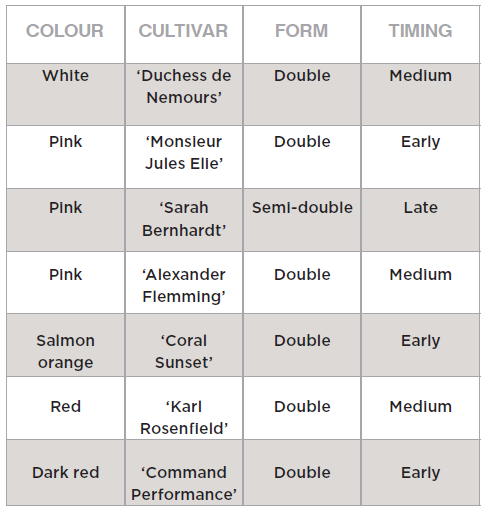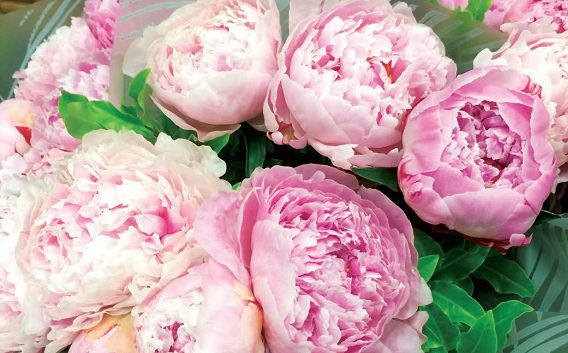Andy Whelton explores the potential for peonies for the cut flower sector emerging from current applied research work being undertaken on the crop at Kildalton College
There continues to be a growing demand for Irish sourced cut flowers by both the supermarket trade and high street florists as alluded to by florist Ruth Monahan in the summer 2017 edition of Horticulture Connected. In response to this increased appetite, Teagasc has been conducting trials at Kildalton College, County Kilkenny over the past few years. Peony cultivars being screened in a trial planted in 2014 are now showing promise as a potential cut flower crop in Ireland.
 The herbaceous peonies are the most useful for cutting and have increased in popularity in recent years owing to their hardiness, large size, colour and fragrance of flowers. They are a long-term crop and once planted they do not like to be disturbed. They can crop for up to 15-20 years.
The herbaceous peonies are the most useful for cutting and have increased in popularity in recent years owing to their hardiness, large size, colour and fragrance of flowers. They are a long-term crop and once planted they do not like to be disturbed. They can crop for up to 15-20 years.
While the primary aim of the Kildalton trial is to evaluate a range of cultivars in terms of flowering date and stem yield, information on other key agronomy aspects of production is also being gathered.
Peonies require a sheltered site from prevailing winds. While a south facing aspect is desirable, it is not essential. The south-east of Ireland appears to be a very suitable production area due to the somewhat drier climate and good, free-draining, deep mineral soils, which they enjoy. However, they will tolerate a wide array of soil Ph with the ideal range between 6.0 to 7.0. Source of plant material is crucial to success and rootstock is available from specialist producers in Holland. The crop is generally planted on single ridges, not too dissimilar to potato ridges. They can also be planted on beds. In the Kildalton plot 18’’ (45 cm) ridges are adopted and crowns are spaced to give a plant density of 1.5 plants per square meter. Closer spacing can affect longevity and quality. Planting is normally carried out in late autumn to allow good root establishment before
the winter. It is important to not set them too deep (30-35mm of soil over the crowns is sufficient). It is critically important to keep plantations free of weeds. The site should be first cleared of perennial weeds by spraying off. Residual herbicides such as Stomp Aqua and Butisan S have label recommendation.
A soil test is necessary to accurately determine rates of phosphorus and potash. A balanced compound should be used as a top dressing in the spring. The judicious use of nitrogen will result in good growth response in spring and up to 100 kg/ha of nitrogen can be applied to a mature crop.
CHOICE OF CULTIVAR
College amenity technician, Catherine Gavin oversees the cultivar trial work at Kildalton and she has been monitoring up to 20 cultivars of peonies, keeping records on emergence, flowering date, stem yield, pest and disease susceptibility. All growth originates from an underground crown. The stem buds or eyes are formed at the top of the crown and are the beginning of the next year’s growth. Single and double flowering cultivars, early, mid and late flowering cultivars are being screened. The trial, while only in its third season, is already showing differences between cultivars. The table below shows features of some of the range being trialed in Kildalton.


Choice of cultivar will ultimately depend on market outlet and specification. ‘Sarah Bernhardt’ is a well-known cultivar widely grown commercially in Holland and popular amongst the supermarket trade and is by far the highest yielding even after three seasons, but is later flowering compared to most others. Monitoring will continue on an annual basis in the trial, the results of which will then be collated and presented to the industry in the future.
SLUGS AND BOTRYTIS
Slugs were problematic in Kildalton in 2017 and certainly in wet season’s damage seen from early spring right through to the autumn. They can damage the young shoots as they emerge, affecting flower quality by distorting buds and stems and ultimately reducing stem yield.


| Catherine Gavin and Andy Whelton evaluate stage of harvest of Paeonia ‘Sarah Bernhardt’ – a popular high yielding late flowering cultivar in the Kildalton trial |
Stem and bud botrytis (grey mould) is the main disease issue with the crop and a programme for control has to be implemented from emergence in the spring. The programme should be maintained throughout the growing season through harvest and should extend out to early autumn. The Kildalton programme consisted of alternating systemic fungicides such as Rovral WG and Switch which have full label recommendations with protectants such as Amistar and Signum which have off-label approval.
CUTTING STAGE IS CRUCIAL
Harvesting can commence from late April to early May and continues through to mid-June. Stems are ready when the bud feels soft to touch and the first petal (flag) is just showing signs of colour and lifting. Cut off preferably above the first set of leaves from the base, remembering that to rehabilitate the plant for next year’s production, a good cover of leaves must be left. Generally, stems are cut early in the morning and moved to the cold store as quickly as possible to maintain quality. Buds must be dry on harvesting. Once in the store, the stems are graded, removing the lower spare leaves leaving two or three sets on the stem. They are usually sorted into lengths 50-60cm and 60-70cm. Stems are bunched in five’s of the same sizes. Chill at 1-3°C. Peonies store dry for up to three weeks in a cool store. Prior to shipment, they are put into boxes with 50 stems per box.
Foliage is normally cut down in the autumn when it turns colour and not before. Cut to 10cm of ground level and dispose of foliage. A cleanup herbicide such as Retro can be used to maintain plantations free of weeds.
PROFIT AFTER FIVE YEARS
A minimum of five years is needed before peonies become profitable. Capital during the first three years is spent on plants, soil improvements, establishment, cultivating and overhead expenses. Only in the following two years will plants produce sufficient stems to realise a profit. New plants produce three to five stems in the second year with full cropping potential reached by year five when an average of eight to 12 blooms are produced from a well-managed crop (120,000 blooms/ha). Growers can expect €0.35 to €0.45 per stem, depending on market and quality grade. From an initial investment of €12,000 per ha, a gross return of €42,000 per ha is achievable from the fifth year onwards. Net return can be in the region of €24,000 per ha. ✽
  by email andy.whelton@teagasc.ie for further information on cultivation of the crop or Catherine Gavin at Kildalton College (Catherine.gavin@teagasc.ie) to view the crop during the growing season (by appointment only). |










